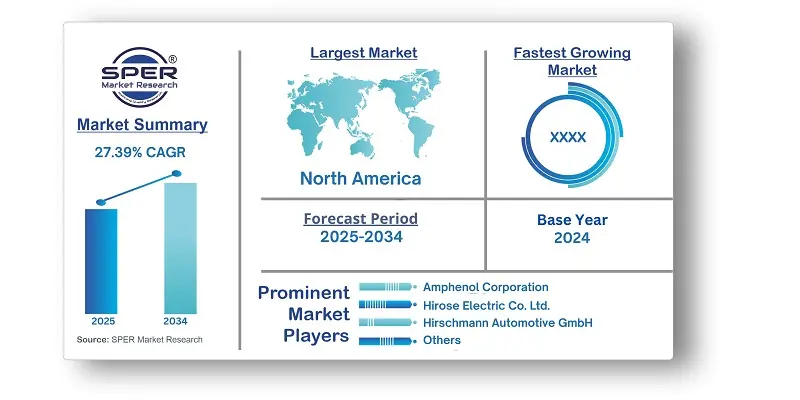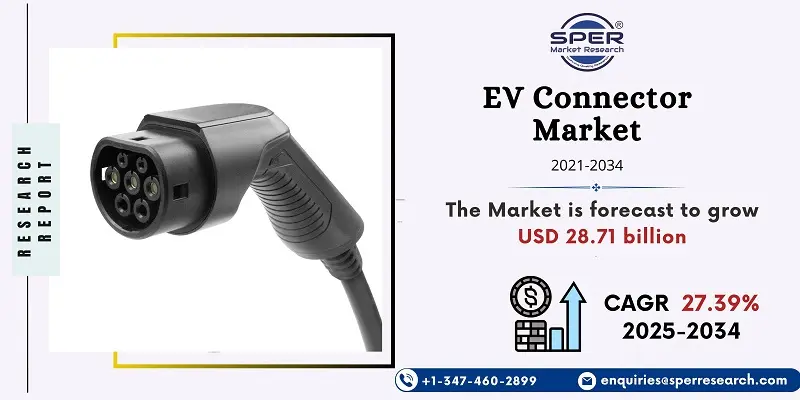Global EV Connector Market Introduction and Overview
According to SPER Market Research, the Global EV Connector Market Growth is estimated to reach USD 28.71 billion by 2034 with a CAGR of 27.39%.
The report includes an in-depth analysis of the Global EV Connector Market Growth, including market size and trends, product mix, Applications, and supplier analysis. The global EV connector market has grown significantly as a result of increased electric vehicle adoption, government incentives, and a push to reduce carbon emissions. Increased investments in EV infrastructure, particularly fast-charging technologies and smart grid integration, have fueled market growth. Furthermore, regulatory bodies' standardization efforts and growing partnerships between automakers and energy providers have improved compatibility and interoperability, facilitating wider adoption. However, the market faces significant challenges, including a lack of universal charging standards, high initial infrastructure costs, and regional disparities in EV adoption rates. Technical challenges such as thermal management, connector durability under high power loads, and safety concerns all impede seamless implementation.

By Current Insights
The Global EV Connector Market is segmented into three types of current: AC connectors, DC Connectors and Combined Connectors. DC connectors currently dominate the global EV connector market, accounting for the majority of market share and growth potential. This is primarily due to the growing demand for fast-charging infrastructure, which significantly reduces charging time, an important consideration for both private EV users and fleet operators. Governments and private stakeholders are making significant investments in DC fast-charging stations to meet the demands of long-distance and high-use electric vehicles, particularly in urban and highway networks. DC connectors can deliver more power (often exceeding 50 kW), making them better suited for rapid charging applications than traditional AC connectors, which are typically limited to lower power levels.
By Voltage Insights
In terms of Voltage, the Global EV Connector Market is divided into three categories: low, medium and high. Due to escalating geopolitical tensions and a growing need for national security, the defense and security segment dominated the market in 2024. Governments make significant investments in satellite surveillance, reconnaissance, and intelligence gathering capabilities to improve situational awareness and response strategies. Using advanced technologies like artificial intelligence and machine learning to analyse satellite data expands defense agencies' capabilities. Additionally, the use of satellite data in security applications is growing as a result of the focus on cyber defense and the requirement to monitor vital infrastructure.
By Connection Insights
In terms of connection, the Global EV Connector Market is divided into three categories: wire-to-wire, wire-to-board, and board-to-board. The wire-to-board connection type currently dominates the EV connector market. This dominance stems primarily from its critical role in connecting various subsystems in electric vehicles, including battery management systems (BMS), power distribution units (PDUs), and onboard chargers. Wire-to-board connectors are popular in automotive electronics due to their mechanical stability, current-carrying capacity, and ease of assembly, making them ideal for compact and high-density vehicle designs. Furthermore, as EVs become more reliant on advanced electronic control systems and intelligent power modules, wire-to-board connectors enable dependable signal and power transmission between PCBs and peripheral components.
By Application Insights
In terms of application, the Global EV Connector Market is divided into five categories: Charging, Body Control & Interiors, Infotainment Systems, Powertrain & Engine Management, Battery Management System, and Others. The Charging segment dominates the global EV connector market by application, owing to the growing global demand for electric vehicle infrastructure and the critical role connectors play in high-power energy transfer. EV charging, particularly DC fast charging, necessitates robust, thermally stable, and safety-certified connectors, resulting in significant innovation and investment in this field. The proliferation of public and residential charging stations, combined with government incentives and strict emission regulations, has accelerated the adoption of advanced EV charging connectors.
By Regional Insights
The market for EV connectors in Asia Pacific had the biggest revenue share in 2024. A major factor in the market's growth is investments made in the area's charging infrastructure. To support the expanding EV market, governments and private organizations are investing significant funds in creating a strong network of EV charging stations. Because of these investments, there is a need for different kinds of EV connectors to make it easier for cars to connect to charging stations. Manufacturers of EV connectors thus profit from providing parts that are essential to the development and growth of the charging network throughout the area.
Market Competitive Landscape
Fast-charging and high-voltage capabilities are key features of the fiercely competitive global EV connector market, which is also marked by rapidly changing standards and technological innovation. Some of the key market players are Amphenol Corporation, Aptiv, Hirose Electric Co. Ltd., Hirschmann Automotive GmbH, ITT Inc., Molex, Rosenberger Hochfrequenztechnik GmbH & Co. KG, Sumitomo Electric Industries Ltd., TE Connectivity and YAZAKI Corporation.
Recent Developments:
In October 2023, India's National Standard Body, the Bureau of Indian Standards (BIS), authorized IS17017 (Part 2/Sec 7): 2023 for Light Electric Vehicles (LEVs), the nation's first internally created. This is the first combined AC and DC charging connector standard in the world that is specifically designed for LEVs and was painstakingly created in India.
In June 2023, in order to incorporate the North American Charging Standard (NACS) connector design into its electric vehicles starting in 2025, General Motors (GM) announced a collaboration with Tesla. The collaboration intends to improve GM EV drivers' access to charging at Tesla Superchargers across North America.
Scope of the report:
| Report Metric | Details |
| Market size available for years | 2021-2034 |
| Base year considered | 2024 |
| Forecast period | 2025-2034 |
| Segments covered | By Current, By
Voltage, By Connection, By Application |
| Regions covered | North America, Latin America, Asia-Pacific, Europe, and Middle East
& Africa |
| Companies Covered | Amphenol
Corporation, Aptiv, Hirose Electric Co. Ltd., Hirschmann Automotive GmbH, ITT
Inc., Molex, Rosenberger Hochfrequenztechnik GmbH & Co. KG, Sumitomo
Electric Industries Ltd., TE Connectivity and YAZAKI Corporation |
Key Topics Covered in the Report
- Global EV Connector Market Size (FY’2021-FY’2034)
- Overview of Global EV Connector Market
- Segmentation Global EV Connector Market By Current (AC connectors, DC Connectors, Combined Connectors)
- Segmentation Global EV Connector Market By Voltage (Low, Medium, High)
- Segmentation Global EV Connector Market By Connection (Wire-to-wire, wire-to-board, board-to-board)
- Segmentation Global EV Connector Market By Application (Charging, Body control & interiors, Infotainment systems, Powertrain & engine management, Battery management system, Others)
- Statistical Snap of Global EV Connector Market
- Expansion Analysis of Global EV Connector Market
- Problems and Obstacles in Global EV Connector Market
- Competitive Landscape in the Global EV Connector Market
- Details on Current Investment in Global EV Connector Market
- Competitive Analysis of Global EV Connector Market
- Prominent Players in the Global EV Connector Market
- SWOT Analysis of Global EV Connector Market
- Global EV Connector Market Future Outlook and Projections (FY’2025-FY’2034)
- Recommendations from Analyst
1. Introduction
1.1. Scope of the report
1.2. Market segment analysis
2. Research Methodology
2.1. Research data source
2.1.1. Secondary Data
2.1.2. Primary Data
2.1.3. SPER’s internal database
2.1.4. Premium insight from KOL’s
2.2. Market size estimation
2.2.1. Top-down and Bottom-up approach
2.3. Data triangulation
3. Executive Summary
4. Market Dynamics
4.1. Driver, Restraint, Opportunity and Challenges analysis
4.1.1. Drivers
4.1.2. Restraints
4.1.3. Opportunities
4.1.4. Challenges
5. Market variable and outlook
5.1. SWOT Analysis
5.1.1. Strengths
5.1.2. Weaknesses
5.1.3. Opportunities
5.1.4. Threats
5.2. PESTEL Analysis
5.2.1. Political Landscape
5.2.2. Economic Landscape
5.2.3. Social Landscape
5.2.4. Technological Landscape
5.2.5. Environmental Landscape
5.2.6. Legal Landscape
5.3. PORTER’s Five Forces
5.3.1. Bargaining power of suppliers
5.3.2. Bargaining power of buyers
5.3.3. Threat of Substitute
5.3.4. Threat of new entrant
5.3.5. Competitive rivalry
5.4. Heat Map Analysis
6. Competitive Landscape
6.1. Global EV Connector Market Manufacturing Base Distribution, Sales Area, Product Type
6.2. Mergers & Acquisitions, Partnerships, Product Launch, and Collaboration in Global EV Connector Market
7. Global EV Connector Market, By Current 2021-2034 (USD Million)
7.1. AC connectors
7.2. DC Connectors
7.3. Combined Connectors
8. Global EV Connector Market, By Voltage 2021-2034 (USD Million)
8.1. Low
8.2. Medium
8.3. High
9. Global EV Connector Market, By Connection 2021-2034 (USD Million)
9.1. Wire-to-wire
9.2. Wire-to-board
9.3. Board-to-board
10. Global EV Connector Market, By Application 2021-2034 (USD Million)
10.1. Charging
10.2. Body control & interiors
10.3. Infotainment systems
10.4. Powertrain & engine management
10.5. Battery management system
10.6. Others
11. Global EV Connector Market 2021-2034 (USD Million)
11.1. Global EV Connector Market Size and Market Share
12. Global EV Connector Market, By Region, 2021-2034 (USD Million)
12.1. Asia-Pacific
12.1.1. Australia
12.1.2. China
12.1.3. India
12.1.4. Japan
12.1.5. South Korea
12.1.6. Rest of Asia-Pacific
12.2. Europe
12.2.1. France
12.2.2. Germany
12.2.3. Italy
12.2.4. Spain
12.2.5. United Kingdom
12.2.6. Rest of Europe
12.3. Middle East and Africa
12.3.1. Kingdom of Saudi Arabia
12.3.2. United Arab Emirates
12.3.3. Qatar
12.3.4. South Africa
12.3.5. Egypt
12.3.6. Morocco
12.3.7. Nigeria
12.3.8. Rest of Middle-East and Africa
12.4. North America
12.4.1. Canada
12.4.2. Mexico
12.4.3. United States
12.5. Latin America
12.5.1. Argentina
12.5.2. Brazil
12.5.3. Rest of Latin America
13. Company Profile
13.1. Amphenol Corporation
13.1.1. Company details
13.1.2. Financial outlook
13.1.3. Product summary
13.1.4. Recent developments
13.2. Aptiv
13.2.1. Company details
13.2.2. Financial outlook
13.2.3. Product summary
13.2.4. Recent developments
13.3. Hirose Electric Co. Ltd.
13.3.1. Company details
13.3.2. Financial outlook
13.3.3. Product summary
13.3.4. Recent developments
13.4. Hirschmann Automotive GmbH
13.4.1. Company details
13.4.2. Financial outlook
13.4.3. Product summary
13.4.4. Recent developments
13.5. ITT Inc.
13.5.1. Company details
13.5.2. Financial outlook
13.5.3. Product summary
13.5.4. Recent developments
13.6. Molex
13.6.1. Company details
13.6.2. Financial outlook
13.6.3. Product summary
13.6.4. Recent developments
13.7. Rosenberger Hochfrequenztechnik GmbH & Co. KG
13.7.1. Company details
13.7.2. Financial outlook
13.7.3. Product summary
13.7.4. Recent developments
13.8. Sumitomo Electric Industries Ltd.
13.8.1. Company details
13.8.2. Financial outlook
13.8.3. Product summary
13.8.4. Recent developments
13.9. TE Connectivity
13.9.1. Company details
13.9.2. Financial outlook
13.9.3. Product summary
13.9.4. Recent developments
13.10. YAZAKI Corporation
13.10.1. Company details
13.10.2. Financial outlook
13.10.3. Product summary
13.10.4. Recent developments
13.11. Others
14. Conclusion
15. List of Abbreviations
16. Reference Links
SPER Market Research’s methodology uses great emphasis on primary research to ensure that the market intelligence insights are up to date, reliable and accurate. Primary interviews are done with players involved in each phase of a supply chain to analyze the market forecasting. The secondary research method is used to help you fully understand how the future markets and the spending patterns look likes.
The report is based on in-depth qualitative and quantitative analysis of the Product Market. The quantitative analysis involves the application of various projection and sampling techniques. The qualitative analysis involves primary interviews, surveys, and vendor briefings. The data gathered as a result of these processes are validated through experts opinion. Our research methodology entails an ideal mixture of primary and secondary initiatives.





































